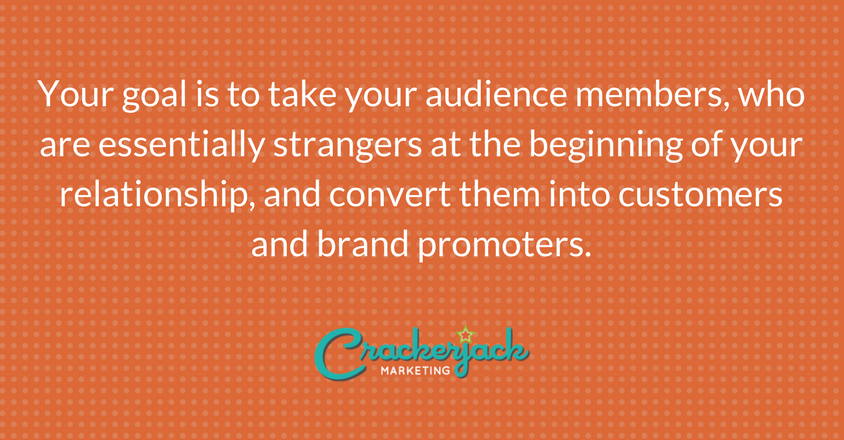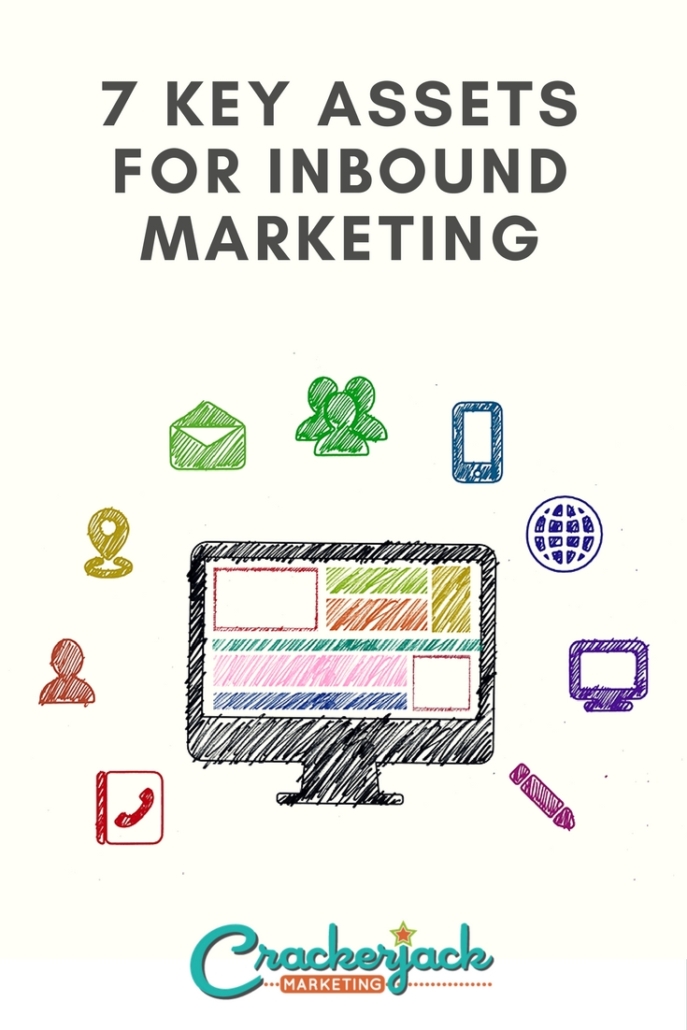7 Key Assets for Inbound Marketing

You likely already have several key inbound marketing assets at your disposal. These platforms help you interest, educate, and entertain your audience, moving your prospects through the inbound marketing continuum. Your goal is to take your audience members, who are essentially strangers at the beginning of your relationship, and convert them into customers and brand promoters. How many of these marketing assets do you already have working for you?

Your Website
This is not just a pretty homepage. It’s your marketing workhorse and your hub of activity. Every inbound marketing step leads back to this asset. Don’t fall into the trap of thinking a great Facebook page can replace your website.
Your Blog
Guess what’s at the start of your marketing efforts? If you guessed your blog, you’re absolutely right. Remember, the start of the inbound marketing continuum should be a wide net, and your blog is perfect for drawing the masses into it. It’s a top asset for drawing those strangers (soon-to-be customers and brand promoters) in from the search engines and social media. You’ll even attract people to your blog via word of mouth.
The content you post to your blog is critical. While it may seem smart to write specific details about your products, services, and deals, doing so can actually turn your audience off. Instead, create content (loosely) around your products and services. What does that mean? Essentially, you want to write about themes of interest to your audience. For example, if your business wants to attract customers who have products and services to sell to teens, your content may focus on such topics as marketing to teens, teen-friendly social media platforms, and marketing via social media.
Social Media
More and more people of all ages are using social media not only to learn about companies, brands, products, and services but also to spread the word about those they like and to make actual buying decisions. This start-of-the-continuum asset serves a dual purpose: discovery, for the strangers who will become your customers, and delight, for delighting people who have already purchased from you.
Other Content
Beyond the blog, you’ll want to have some other types of content on your website, ideally meatier, juicier content that people can sink their teeth into. Whitepapers, eBooks, and downloadable worksheets are all great content that can help move prospective customers through the inbound marketing continuum. And asking people to download this content is part of the next asset, which is….
Calls to Action

What do you want your audience to do? What is the next step? The answer may seem obvious to you, but if you want to move your audience members through the inbound marketing continuum, you’ll need to tell them, and tell them, and tell them again what you want them to do next. This means using calls to action – a request you make of your visitor – on your website, blog, and in your emails. You’ll even want to use them from time to time in social media. Where will they lead? Your calls to action should take your prospects to a dedicated landing page that you use to capture leads before you give them what they’re looking for: advice, worksheets, event invitations, and more.
Email Marketing and Lead Nurturing
Your leads are only valuable if you choose to do the right thing with them. You have to nurture them to move them through the marketing funnel. After you’ve captured leads through your dedicated landing pages, use email to nurture them. Use the following in your emails:
- Free offers
- Content
- Event invitations
- Webinar invites
- Newsletters
Other Digital Platforms
You also have many other digital platforms at your disposal. Any platform that reliably moves your prospects through the marketing funnel is a good choice. While there are many to consider, SlideShare is a good choice, especially for business-to-business. Podcasts are great for boosting engagement and delighting your current customers, and don’t forget events. Events, both online and offline, are useful throughout the funnel for attracting, engaging, converting, and delighting your customers and prospects.
Putting It All Together
As you begin to craft your inbound marketing plans, remember three things:
- You’ll need to use several approaches to bring your audience to you
- You already have effective assets at your disposal
- You’ll get the best results with content tailored to your ideal customer, crafted to travel further and inspire sharing
What other inbound marketing assets are you currently using? What’s worked well for you? Please share your thoughts in the comments.

She’s been in social media for over 20 years, and teaches digital marketing at universities in Barcelona and Bangkok.
Follow her on LinkedIn
for expert LinkedIn and marketing advice.
STEPHANIE SCHWAB
CEO & Founder
Stephanie is the Founder and CEO of Crackerjack Marketing.
She’s been in social media for over 20 years, and teaches digital marketing at universities in Barcelona and Bangkok.
Follow her on LinkedIn
for expert LinkedIn and marketing advice.
Categories
7 Key Assets for Inbound Marketing

You likely already have several key inbound marketing assets at your disposal. These platforms help you interest, educate, and entertain your audience, moving your prospects through the inbound marketing continuum. Your goal is to take your audience members, who are essentially strangers at the beginning of your relationship, and convert them into customers and brand promoters. How many of these marketing assets do you already have working for you?

Your Website
This is not just a pretty homepage. It’s your marketing workhorse and your hub of activity. Every inbound marketing step leads back to this asset. Don’t fall into the trap of thinking a great Facebook page can replace your website.
Your Blog
Guess what’s at the start of your marketing efforts? If you guessed your blog, you’re absolutely right. Remember, the start of the inbound marketing continuum should be a wide net, and your blog is perfect for drawing the masses into it. It’s a top asset for drawing those strangers (soon-to-be customers and brand promoters) in from the search engines and social media. You’ll even attract people to your blog via word of mouth.
The content you post to your blog is critical. While it may seem smart to write specific details about your products, services, and deals, doing so can actually turn your audience off. Instead, create content (loosely) around your products and services. What does that mean? Essentially, you want to write about themes of interest to your audience. For example, if your business wants to attract customers who have products and services to sell to teens, your content may focus on such topics as marketing to teens, teen-friendly social media platforms, and marketing via social media.
Social Media
More and more people of all ages are using social media not only to learn about companies, brands, products, and services but also to spread the word about those they like and to make actual buying decisions. This start-of-the-continuum asset serves a dual purpose: discovery, for the strangers who will become your customers, and delight, for delighting people who have already purchased from you.
Other Content
Beyond the blog, you’ll want to have some other types of content on your website, ideally meatier, juicier content that people can sink their teeth into. Whitepapers, eBooks, and downloadable worksheets are all great content that can help move prospective customers through the inbound marketing continuum. And asking people to download this content is part of the next asset, which is….
Calls to Action

What do you want your audience to do? What is the next step? The answer may seem obvious to you, but if you want to move your audience members through the inbound marketing continuum, you’ll need to tell them, and tell them, and tell them again what you want them to do next. This means using calls to action – a request you make of your visitor – on your website, blog, and in your emails. You’ll even want to use them from time to time in social media. Where will they lead? Your calls to action should take your prospects to a dedicated landing page that you use to capture leads before you give them what they’re looking for: advice, worksheets, event invitations, and more.
Email Marketing and Lead Nurturing
Your leads are only valuable if you choose to do the right thing with them. You have to nurture them to move them through the marketing funnel. After you’ve captured leads through your dedicated landing pages, use email to nurture them. Use the following in your emails:
- Free offers
- Content
- Event invitations
- Webinar invites
- Newsletters
Other Digital Platforms
You also have many other digital platforms at your disposal. Any platform that reliably moves your prospects through the marketing funnel is a good choice. While there are many to consider, SlideShare is a good choice, especially for business-to-business. Podcasts are great for boosting engagement and delighting your current customers, and don’t forget events. Events, both online and offline, are useful throughout the funnel for attracting, engaging, converting, and delighting your customers and prospects.
Putting It All Together
As you begin to craft your inbound marketing plans, remember three things:
- You’ll need to use several approaches to bring your audience to you
- You already have effective assets at your disposal
- You’ll get the best results with content tailored to your ideal customer, crafted to travel further and inspire sharing
What other inbound marketing assets are you currently using? What’s worked well for you? Please share your thoughts in the comments.

Search our Blog
Get our Free Editorial Calendar Template.
Are you stressed out by the time it takes to create great content?
In this handy Google Doc, which you can save and use on your own, you’ll get a super-simple layout to guide your content creation and management efforts.
DOWNLOAD TODAY
STEPHANIE SCHWAB
CEO & Founder
Stephanie founder and CEO of Crackerjack Marketing.
She’s been in social media for over 20 years, and teaches digital marketing at universities in Barcelona and Bangkok.
Follow her on LinkedIn
for expert LinkedIn and marketing advice.
Create your own spark
Join 5,000+ marketers who receive our B2B marketing ideas and insights each week.
Join 5,000+ marketers who receive our B2B marketing ideas and insights each week.
Who We Serve
Company
Who We Are
Our Services
Blog
Free Editorial Calendar Template
Work With Us
Resources
Chicago, Barcelona, Mumbai
1055 W. Bryn Mawr Suite F-196
Chicago, IL 60660
+1-312-429-5588
Headquarters:
© Copyright 2025 Kyle Partners, LLC, d/b/a Crackerjack Marketing. All rights reserved. | Terms of Service | Privacy Policy